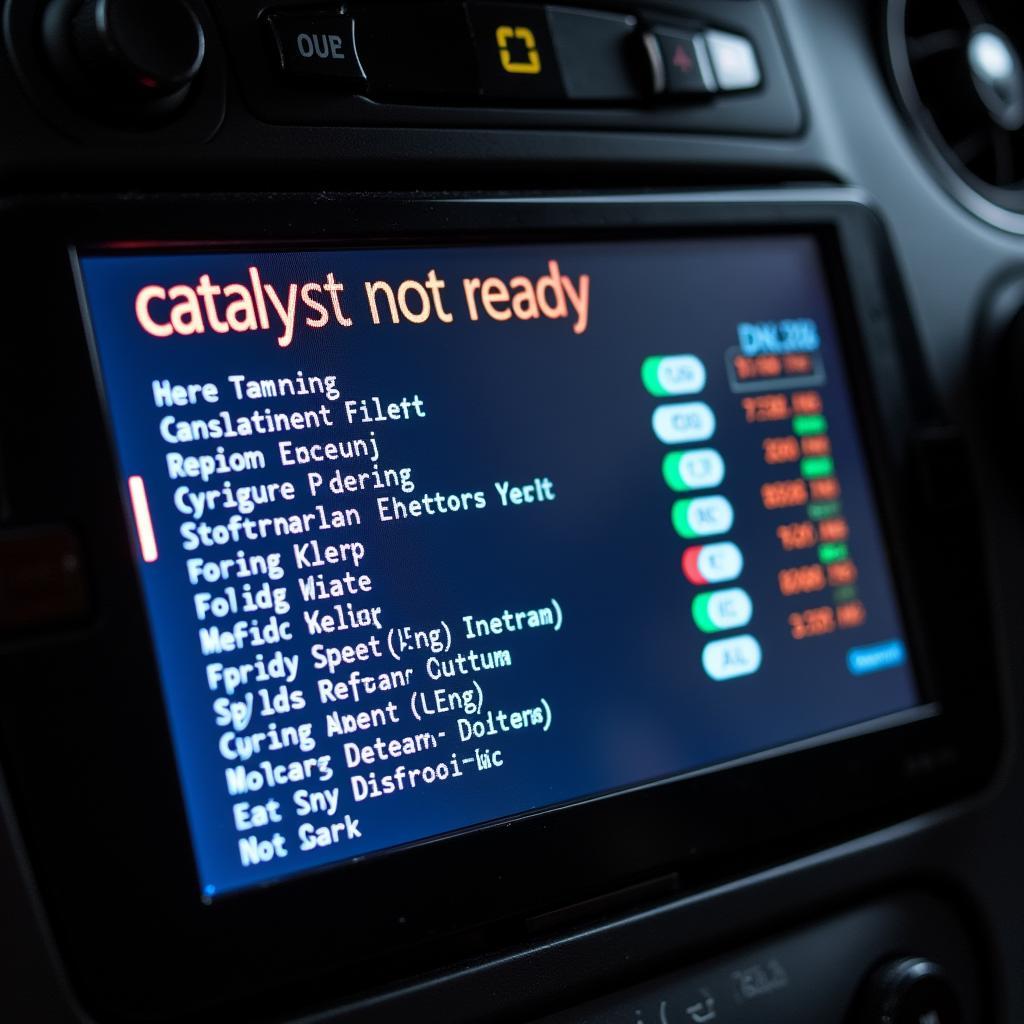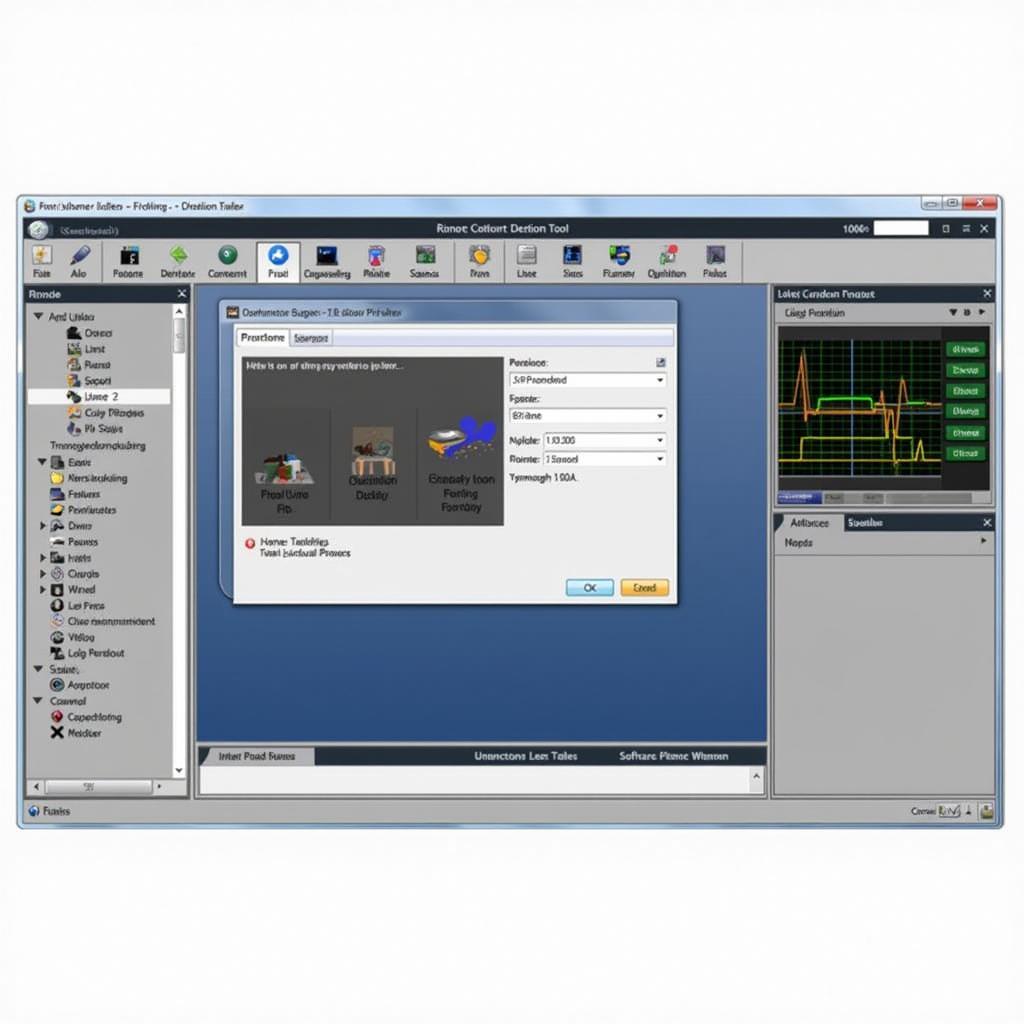Have you recently encountered the “Scan Tool Obd2 Cat Not Ready” message while checking your car’s diagnostics? This cryptic message can be frustrating, especially when you’re unsure of its implications. Don’t worry, this article will guide you through understanding why you’re seeing this message and how to address it effectively.
Deciphering the “Scan Tool OBD2 Cat Not Ready” Message
Before we delve into solutions, let’s understand what this message signifies. OBD2 (On-Board Diagnostics 2) is a standardized system that allows your car’s computer to communicate with a car reader vs scanner. This system monitors various emission-related components, including the catalytic converter (cat).
The “cat not ready” message indicates that the OBD2 system hasn’t gathered enough data to determine if your catalytic converter is functioning correctly. It doesn’t necessarily mean a faulty converter; it simply means the system needs more time to monitor and collect data.
Common Causes for “Cat Not Ready” Status
Several factors can trigger a “cat not ready” message:
- Recent Battery Disconnection or ECU Reset: Disconnecting the battery or resetting the Engine Control Unit (ECU) clears the OBD2 system’s memory, including the catalytic converter monitoring data.
- Incomplete Drive Cycle: The OBD2 system requires a specific set of driving conditions, known as a “drive cycle,” to adequately monitor the catalytic converter. An incomplete drive cycle can lead to the “not ready” status.
- Faulty Oxygen Sensors: Oxygen sensors play a vital role in monitoring exhaust gases, providing data to the ECU for adjusting the air-fuel mixture and assessing catalytic converter efficiency. A malfunctioning oxygen sensor can disrupt this process.
- Other Emissions System Issues: Problems with the evaporative emissions system, exhaust leaks, or a faulty mass airflow sensor can also indirectly impact the catalytic converter monitoring process, leading to a “not ready” status.
 OBD2 Scanner Showing Cat Not Ready
OBD2 Scanner Showing Cat Not Ready
Troubleshooting the “Cat Not Ready” Message
Here’s a step-by-step guide to troubleshoot and resolve the “cat not ready” message:
-
Verify Recent Battery or ECU Reset: If you recently disconnected your car’s battery or reset the ECU, the “cat not ready” message might be temporary. The system likely needs time to re-learn and gather data.
-
Complete a Drive Cycle: A drive cycle involves specific driving conditions that allow the OBD2 system to monitor emissions components effectively. While the exact drive cycle varies depending on the car model, a general approach includes:
- Starting the engine from cold and letting it idle for a few minutes.
- Driving at varying speeds, including city and highway driving, for at least 15-20 minutes.
- Avoiding rapid acceleration or deceleration.
-
Inspect Oxygen Sensors: Oxygen sensors are crucial for catalytic converter monitoring. If you suspect a faulty sensor, consider inspecting them for damage or wear. You can use a multimeter to test their functionality.
-
Check for Other Emissions System Issues: Inspect the evaporative emissions system for leaks, check for exhaust leaks, and ensure the mass airflow sensor is functioning correctly.
-
Utilize an Advanced Scan Tool: If the issue persists, using a more advanced iphone scanning tool can provide in-depth diagnostic information, helping pinpoint the root cause.
When to Seek Professional Help
While troubleshooting the “cat not ready” message can be done independently, seeking professional help is recommended if:
- The issue persists despite following the troubleshooting steps.
- You’re uncomfortable performing car repairs yourself.
- You suspect a more significant issue with the emissions system.
A qualified mechanic can provide accurate diagnosis and repair, ensuring your car runs efficiently and meets emissions standards.
Expert Insights
“The ‘cat not ready’ message often leads to unnecessary panic,” says John Miller, Senior Automotive Technician at Miller’s Auto Repair. “In many cases, it’s simply a matter of completing a full drive cycle after a battery reset. However, persistent issues warrant professional attention to rule out potential emissions system problems.”
Preventing Future “Cat Not Ready” Issues
While not always preventable, you can minimize the chances of encountering this message by:
- Avoiding frequent battery disconnections.
- Addressing check engine lights promptly.
- Maintaining regular car maintenance schedules.
Conclusion
The “scan tool obd2 cat not ready” message, while initially concerning, doesn’t always signify a significant problem. Understanding its causes and following the troubleshooting steps can often resolve the issue. However, seeking professional help is crucial if the problem persists or you suspect underlying emissions system issues. By staying proactive with car maintenance and promptly addressing warning signs, you can ensure your vehicle runs smoothly and remains environmentally compliant.
Need help with your car’s diagnostics or emissions system? Contact ScanToolUS at +1 (641) 206-8880 or visit our office at 1615 S Laramie Ave, Cicero, IL 60804, USA. Our team of experts is ready to assist you!
FAQs
1. Can I drive my car with a “cat not ready” message?
Driving with a “cat not ready” message for a short period is usually acceptable. However, if the message persists, it’s essential to address the underlying issue to avoid potential damage to the catalytic converter or other emissions components.
2. How long does it take for the “cat not ready” message to clear after a battery reset?
The time it takes for the message to clear varies depending on the car model and driving conditions. In many cases, it can take a few complete drive cycles.
3. Will a “cat not ready” status cause me to fail an emissions test?
Yes, a “cat not ready” status will likely result in an emissions test failure. The system needs to gather sufficient data on the catalytic converter’s functionality to pass the test.
4. Is it expensive to replace a catalytic converter?
Catalytic converter replacements can be costly due to the precious metals used in their construction. The cost varies depending on the car model and the type of converter required.
5. Can a faulty oxygen sensor damage my catalytic converter?
Yes, a malfunctioning oxygen sensor can disrupt the air-fuel mixture, potentially leading to damage to the catalytic converter over time.
6. Can I clear the “cat not ready” message with a code reader?
While a code reader can clear the code, it won’t solve the underlying issue. The message will likely reappear unless the root cause is addressed.
7. How often should I have my car’s emissions system checked?
It’s generally recommended to have your car’s emissions system inspected annually or as part of your regular maintenance schedule.


